Introduction: T. I. LIFE Puzzle for August 2019
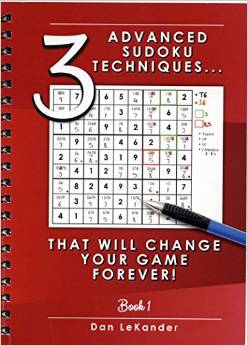
DAN’S 8-STEP APPROACH TO SOLVING ALL SUDOKU PUZZLES
Once you have completed the puzzle, to the extent that you have filled-in all obvious answers and have written all potential options across the top of the unsolved cells (PUZZLE PREPARATION), Dan recommends the following Steps to complete the puzzle.
Step 1: Sudoku Pairs, Triplets and Quads – See September 2015
Step 2: Turbos & Interaction – See October 2015
Step 3: Sudoku Gordonian Rectangles and Polygons – See November 2015
Step 4: XY-Wings & XYZ Wings – See December 2015
Step 5: X-Wings – See January 2016
Step 6: DAN’S YES/NO CHALLENGE
Step 7: DAN’S CLOSE RELATIONSHIP CHALLENGE
Step 8: AN EXPANSION OF STEP 7
Steps 1-5 are relatively common techniques and are explained in the TI LIFE articles above. Steps 6-8 are covered in detail, in Dan’s book.
This month we are going to take the next logical step in Puzzle Preparation, now that you have developed experience with the concepts.
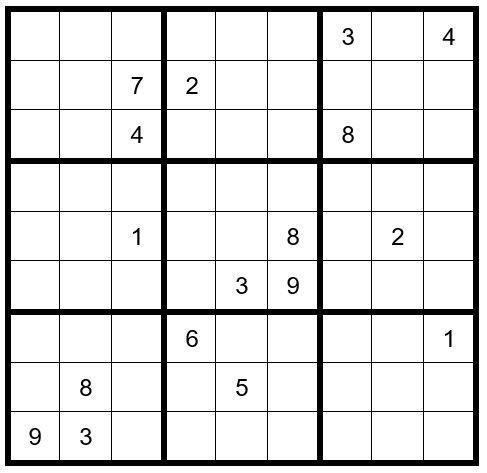
PUZZLE PREPARATION
Prior to utilizing techniques first complete the 5 Steps of Puzzle Preparation …
- FILL IN DATA FROM OBSERVATIONS
- FILL IN OBVIOUS ANSWERS
- FILL IN NOT-SO-OBVIOUS ANSWERS
- MARK UNSOLVED CELLS WITH OPTIONS THAT CANNOT EXIST IN THOSE CELLS
- FILL IN THE OPTIONS FOR THE UNSOLVED CELLS
In contrast to previous months, we will complete all of the first 4 steps in the order we observe them, versus all step 1, then step 2, step 3, and step 4 in order, before we move on to step 5.
We will start with the 1’s and navigate through 2’s to 9’s, then repeat the process until we conclude all step 1-4 clues. The first thing we observe is that C1R8 (cell in column 1, row 8) =1 (obvious answer).
We then observe that the only two cells in box 7 (lower left-hand box of 3x3 cells) that can contain options 4 and 7 are C1R7 & C2R8, so we shall mark those two cells with options 47. We notice with the 2’s that the only two cells in box 5 that can have a 2 as an option are C5R4 and C6R4, telling us that C1R4, C2R4 and C3R4 cannot have 2 as an option. Now your grid should look like Example #57.1 below.
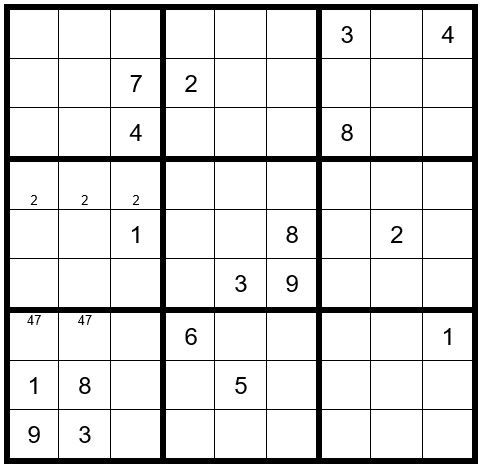
We also see that C9R3=2. Next, we observe that the only cell in column 3 that can be a 3 is C3R4. Given that clue, we see that the only cell in column 3 that can be a 9 is C3R1. And then the only cell in column 3 that can be an 8 is C3R6. Now your grid should look like Example #57.2 below.
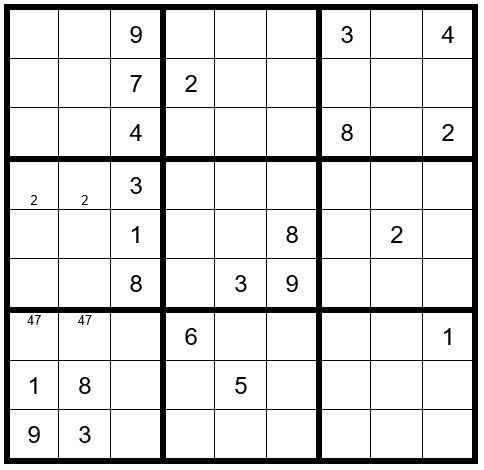
In further looking at the 3’s we see an obvious choice with C9R5=3. Looking at the 7’s we see that the only cells in box 3 that can be a 7 are C8R1 & C8R3, therefore, a 3 cannot exist in C8R4, 6, 7, 8 or 9. Now your grid should look like Example 57.3 below.
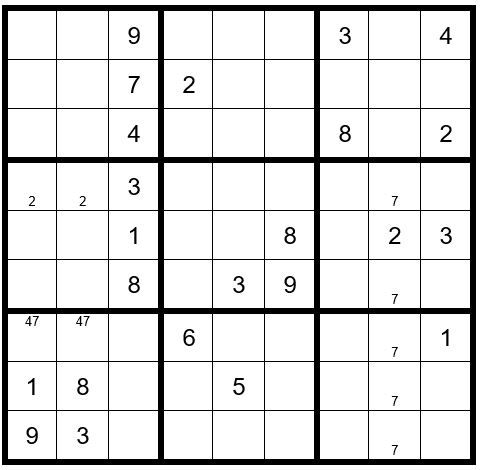
We have now completed Puzzle Preparation steps 1-4, so we will fill in the options for the un-solved cells, remembering that a 4 or 7 cannot exist in any other unsolved cells in row 7 be-cause of the obvious pair 47 in C1R7 and C2R7. Now your grid should look like Example #57.4 below.
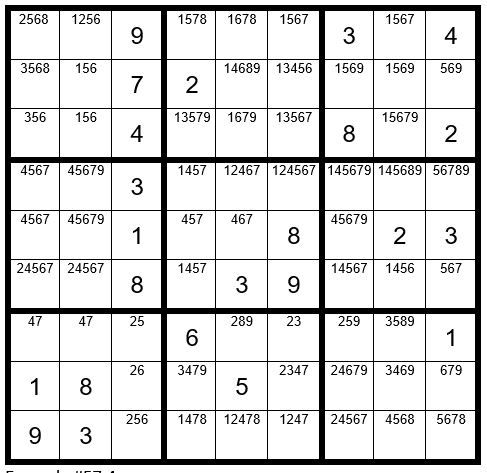
STEPS 1-8
Starting with Step 1 … PAIRS, TRIPLETS, QUADS & QUINTS we search our grid. Do you find any clues? There are at least 2 clues.
In column 4 we see that only two cells contain the two options 39, which are C4R3 an C4R8, a hidden pair. Change your options for those two cells to 39.
Also, in row 2 we see that four cells C2R2, 7, 8, and 9 contain only the options 1569, an obvious quad. You can eliminate options 1569 from the other cells in row 2. Now your grid should look like Example #57.5 below.
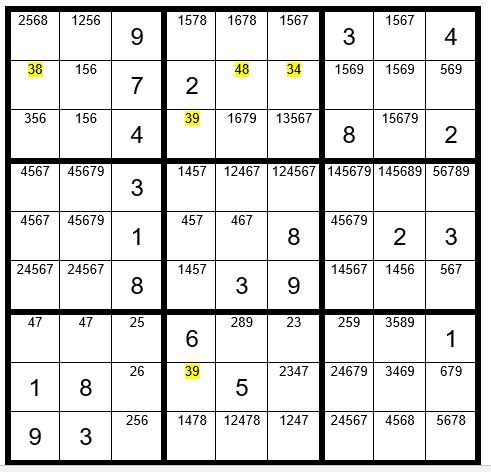
We have created Step 2 … INTERACTION in row 2. Either C7R2, 3 or 4 must be a 9; therefore a 9 cannot exist in C8R3. Now your grid should look like Example #57.6 below.
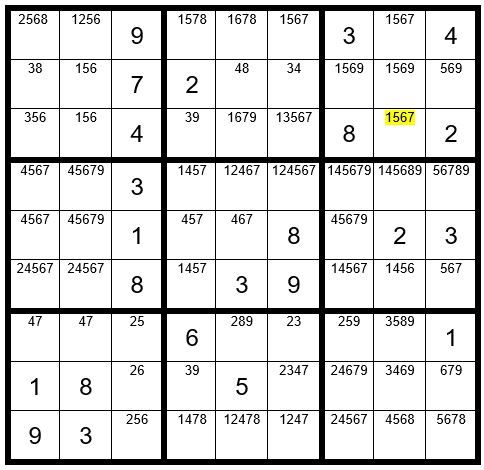
There are no additional Step 1 – 5 clues, so we will now proceed to Step 6: Dan’s Yes-No Challenge.
There are three circumstances that establish the potential for a Step 6 exercise:
- Look for just 2 unsolved cells in a box that contain the same option where these 2 cells are not in the same row or column.
- Look for just 2 unsolved cells in a column that contain the same option where these 2 cells are not in the same box.
- Look for just 2 unsolved cells in a row that contain the same option where these 2 cells are not in the same box.
We will start by searching the 1’s to see if there is a potential Step 6 clue, and then navigate through the 2-9’s.
As you search through the grid, you find that there are numerous candidates, such as in column 4 there are only two cells that contain the option 8, however, they do not track through the puzzle to give you any valid clues, so we will move on to Step 7: Dan’s Close Relationship Challenge.
In this exercise we will select any two-option unsolved cell as the driver cell. My first choice is C6R2, in the sequence 4,3. I will explain this choice after the exercise.
Follow the logic below in Example #57.7.
We know that C6R2 must be a 4 or 3. First, we will assume it is a 4 (hence sequence 4,3). If this is true, then C6R4, 8 and 9 cannot be a 4 (hence the notation N4).
Next, we will assume C6R2 is a 3. If this is true, then only 1 of the cells C6R4, 8 and 9 can be a 4, and hence two of them cannot be a 4. This exercise is to determine which of those 3 cells cannot be a 4.
The next step is to “track” the influence of C6R2 being a 3 through the puzzle to see what the value would be for the N4 cells.
If C6R2=3, then C1R2=8 and C5R2=4. Note these values are also placed in the second level of the cells per below. Continuing on, C4R3=9. C4R8=3. C6R7=2. C3R7=5. C7R7=9. C5R7=8. C8R7=3. C1R3=3. Now your grid should look like Example #57.7 below.
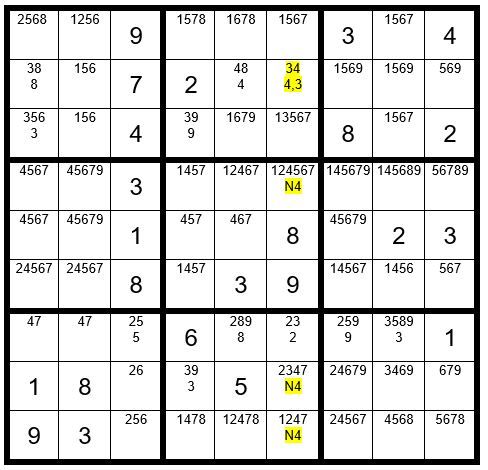
To clarify where we are, we will next put the remaining options for the unsolved cells in the second level of each of those cells, giving us Example #57.8. We utilize the second level (and the third level of the N4 cells) simply to maintain the original puzzle in the first level of the un-solved cells.
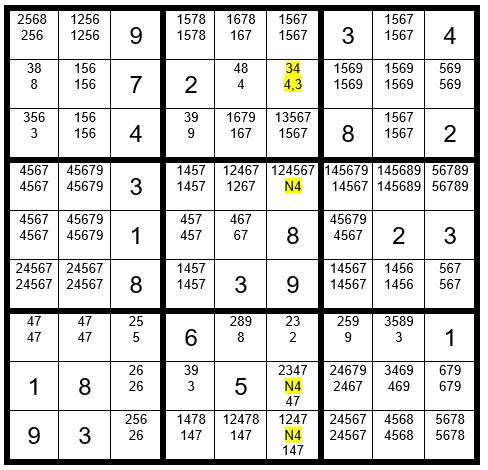
We will pause here and look at box 8. What do you observe?
There are 4 cells that contain the 3 options 147! That cannot be. Another way to look at box 8 is that there is no possibility for a 9 to exist in one of the cells. Whichever way you look at it, it is obvious that C6R2 cannot be a 3! Therefore, C6R2=4.
Essentially, we uncovered a conflict before we defined what the value of C6R4, 8 and 9 was.
There are many ways a Step 7 can play out. Another way, had there not been a conflict, is to determine the values of C6R4, 8 and 9. The two cells that were not a 4 would indicate that they are not a 4 regardless of whether the driver cell C6R2 was a 3 or 4, and the 4 could have been eliminated as an option for those two cells.
Another potential outcome is that you are left with a Gordonian Rectangle for the last 4 unsolved cells, indicating again that the 3 cannot be the actual solution for C6R2. Another possibility is that the 3 may have tracked out and solved the puzzle (this would have been the situation had selected sequence 3,4 vs 4,3).
Earlier I mentioned that we would discuss the reasoning to pick C6R2 and the sequence as the driver cell. I looked for a 2-digit cell where the first number of the sequence had more that 1 possibility in the same box, column or row. The second number could track easily through the puzzle (this would have been the situation had we selected sequence 4,3).
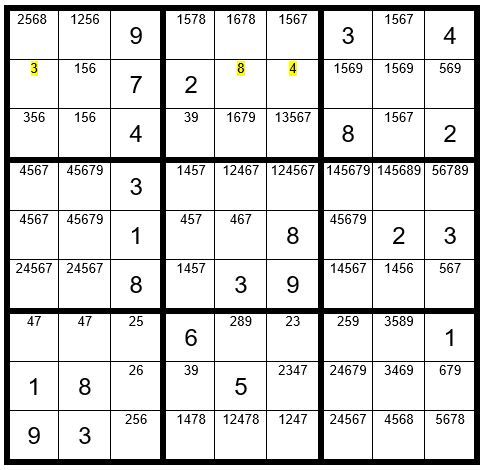
Per Example #57.9 above, we know that we know C6R2=4, then C5R2=8. C1R2=3.
Then, continuing on your grid, C1R1=8. C2R1=2. C1R6=2. C4R8=8. C8R7=8. C6R7=3. C9R4=8. C4R3=3. C4R8=9. C7R7=9. C5R7=2. C3R7=5. C6R8=7, and so forth to an easy completion. Your final grid should look like Example #57.10 below.
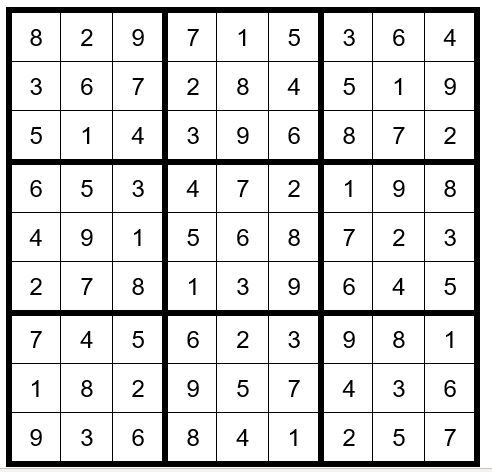
Remarks about Step 7 …
• I define a “Successful Step 7” as one that at least eliminates one option from one unsolved cell.
• It may take several successful Step 7’s to finally solve a puzzle.
• Some Step 7 exercises do not track far enough through the puzzle to give you a success.
• Step 7 is a very powerful technique and can be employed on any 2-digit unsolved cell, either successfully or unsuccessfully.
• Step 7 does not require guessing. It is a planned exercise.
Once you have performed this technique a few times it will become second nature, fun and yield surprising results.
May the gentle winds of Sudoku be at your back.
By Dan LeKander, Wellesley Island
Editor's Note: In January 2016, we published a final article in his series – but many of us enjoy using “Dan’s Steps,” so when he asked if we would like a puzzle to solve every month … this editor said an enthusiastic… Yes, please! Now we are several years later and on Puzzle #55 and # 56!
I suggest you purchase Dan’s book: “3 Advanced Sudoku Techniques, That Will Change Your Game Forever!” Purchase of a book includes a 50-page blank grid pad, 33 black and two green tokens, to assist with Step 6.…
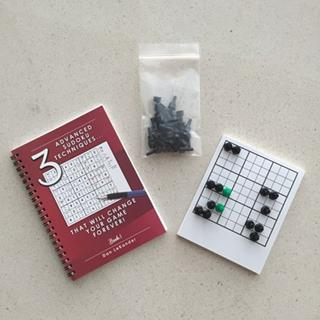
The book is available online, amazon.com and on ebay.com.
Most importantly, I ask that you leave comments on any part of his series and throughout the year.
And now we are halfway through 2019... many puzzles later... I want to thank Dan…and his proofreader… Peggy! I am hoping you will enjoy our monthly Sudoku and at the same time join me in saluting Dan - Bravo to you both…(Mind you sometimes I am not so polite when I can't solve the puzzle...)
Be sure to read the review of Dan's book by Jesse Kahn published in Jun 2015.
Also all past Sudoku Puzzle Challenge beginning: February 2016, March 2016, April 2016, May 2016, June 2016, July 2016, August 2016, September 2016, October 2016, November 2016, December 2016, January 2017, February 2017, March 2017 , April 2017, May 2017, June 2017, July 2017, August 2017, September 2017, October 2017, November 2017 , December 2017, January 2018, February 2018, March 2018, April 2018.May 2018, June 2018, July 2018, August 2018, September 2018 , October 2018, November 2018, December 2018, January 2019, February 2019, March 2019, April 2019, May 2019 June 2019 and July 2019.
Posted in: Volume 14, Issue 8, August 2019, Sports
Please click here if you are unable to post your comment.
